patterns >  Scandiwork website and 1 more...
Scandiwork website and 1 more...
> Brooks Cardigan


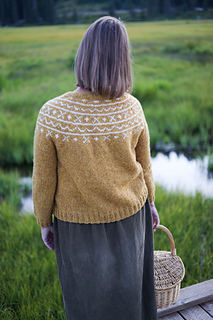



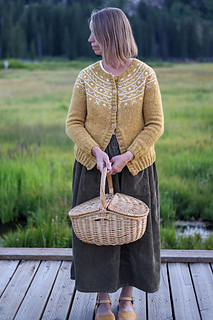
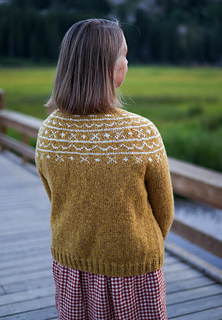
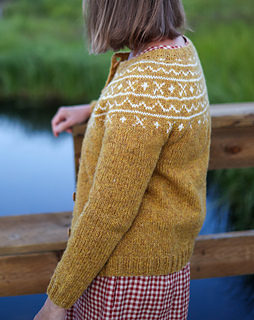
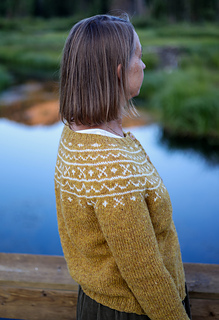
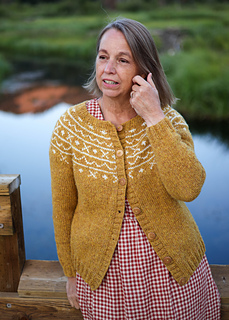
Brooks Cardigan
BROOKS CARDIGAN (top down or bottom up)
Knit this versatile all-season cardigan your favorite way! Choose the method you love to knit, top down or bottom up, and download whichever pattern you prefer.
My Brooks cardigan is knit with seamless construction in the round with a Steek.
The timeless design was inspired by an antique kitchen bowl that has been in my family longer than I have been. It’s Xs and 0s and the tiers with buntings have always reminded me of the icing on a Norwegian Kransekake (a tiered wreath cake). It’s simple, but also a little celebration. For years I have looked at this bowl and thought it should be a sweater. I meant this design to be a constant year-round sweater, a favorite to be worn everywhere. A sweater that hangs on the peg, and one you’d reach when you go for a walk, a trip to the store, to work or school, on a chilly evening, or even a sweater that can be worn over an apron while baking or thrown on to gather eggs. It’s a best friend sort of sweater, that is worn through thick and thin. Good days and bad. A constant companion through life and a classic year in and year out. I knit mine with Biches et Buches Le Lambswool, that gets softer with every wear.
Top-down and bottom-up knitting both have advantages and things to love about the process. The process is similar but, um… different. Here are some of the things I love about both ways to knit a yoke sweater.
Top-down knitting is a modern way to knit. It starts with the neckband and moves quickly to the colorwork yoke and is knit from top to bottom. I love to jump right to the colorwork. Top down knitting is really a great project for a colorwork class. The yoke is shaped with increases. Once the yoke is completed, the stitches are divided into the sleeves and the body. This method makes it easy to try on your cardigan as you go and tailor-fit the yoke depth and length of the body and sleeves. It also is easy to seamlessly pick up the underarm stitches for the sleeves. It is also very rewarding to have the beautiful yoke smiling at you the whole time you knit the body. It encourages you to finish because you can’t wait to wear it. There is minimal finish work in top-down knitting.
Bottom-up knitting is the traditional way to knit a yoke sweater. It’s super portable and quick to knit. It starts with knitting the body, then you knit the sleeves separately. If this is your first bottom-up yoke sweater, you will be pleasantly surprised how quickly the sleeves knit up! . As soon as you finish each sleeve, you will connect it to the body. Once the body is joined to both sleeves, you knit a few rounds, then the fun part starts. I like saving the colorwork for last, the anticipation of working the yoke is motivational to me, It’s like dessert. The yoke is shaped with decreases. The longtail cast-on has the perfect stretch for the cuffs and waistband. I love the traditional V shape of the stitch, especially in colorwork. And you can’t underestimate the bonus it is to be able to tailor fit the neckband. Bottom-up knitting also has minimal finishing work, but you do have to finish the underarms. I have tricks that makes this a snap.
Both patterns have instructions for short rows. I loved this sweater so much, that I wanted you to be able to knit it your favorite way. I knit it both ways and loved every minute of it.
Materials
Biches & Bûche Lambswool | DK | 170 m or 185 yards per 50-gram skein
Main Color: Mustard Yellow 250 (250, 300, 300, 300, 350, 350, 350, 400, 400, 400, 400, 400, 450) grams. Or approx. 815 (870, 948, 1017, 1065, 1123, 1181, 1299, 1357, 1413, 1472, 1531, 1591, 1650) yards
Contrasting Color: Off White 1 50-gram skein or approx. Contrasting Color: Off White 1 50-gram skein or approx. 50 (50, 50, 100, 100, 100, 100, 100, 100, 100, 100, 100, 100, 100) grams. Or approx. 132(142, 152, 172, 182, 192, 202, 212, 222, 230, 242, 252, 262, 280) yards
Needles: Ribbing: US 4 /3.5 mm 32 or 40 – inch/ 80 or 100 for the body and neckband and a set of dpns or flexiflips for cuffs
Main body and sleeves: US 6 / 4mm 32 or 40- inch/ 80 or 100 cm for body, 16-inch/40 cm circular needles for sleeves
Colorwork yoke: US 7 (4.5 mm) or 32 or 40-inch/ 80 or 100 cm
Notions: 7 to 9 ¾” / 2 cm buttons, a tapestry needle, a sewing machine (or needle and thread to secure the steek by hand) and a gauge-sized crochet hook E-4 mm (3.5 mm) used to work a row of crochet to conceal the cut steek stitches.
Gauge and Swatch
20 stitches and 23 rows = 4 inches colorwork
20 stitches and 26 rows = 4 inches in single color
Please swatch in the round, to determine needle size.
Note swatch in both one color and in colorwork to determine needle size.
Sizes
1 (2, 3, 4, 5, 6, 7, 8, 9,10, 11, 12, 13, 14) with a 3 to 6-inch positive ease.
Sample sweater (in photos) is size 3 with a 3” positive ease.
Finished Measurements
Chest circumference: 31(33, 35.75 ,38, 40.5, 42.75 ,45.25, 47.75, 50, 52.25, 55, 57.25, 59.75, 62) inches
Body length from cast on edge to underarm: 11.5 (12, 12.5, 12.5, 13.25, 13.75, 14.25, 14.25, 15.25, 16, 16, 16, 17, 17) inches
Sleeve length: 16 (16.5, 17, 17, 17, 17.5, 18, 18, 18, 18, 19, 19, 19.5, 19.5)”
Yoke depth without neckband: 8 (8, 8.25, 8.5, 8.5, 8.75, 9, 9.5, 10,10.5 ,10.5,
10.5 ,10.75,10.75) inches
Total length: 21 (21, 22.25, 22.5, 23.5, 24.25, 25, 25.5, 27, 27.5 ,27.5, 28.5, 28.75, 28.75) inches
Skills used to knit Brooks
Long-tail cast on
Knitting
Purling
Knitting and purling
Knitting in colorwork
k2tog
SSK
Backward loop
Stranded knitting in colorwork
Catching floats
k2, p2 rib
Securing and cutting a Steek
Single Crochet
Binding off (Casting off)
Duplicate Stitch
Picking up and knitting Stitches
Making my new favorite buttonhole
Sewing on buttons
German short rows
Paying attention to gauge
583 projects
stashed
453 times
- First published: August 2025
- Page created: August 26, 2025
- Last updated: November 24, 2025 …
- visits in the last 24 hours
- visitors right now




